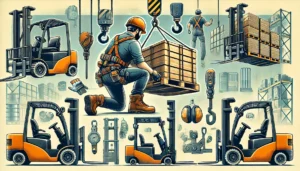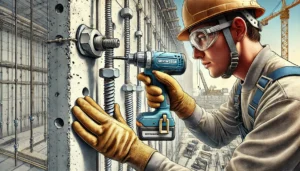Operating power tools comes with a risk, but it is manageable with the implementation of proper safety measures. Taking safety precautions goes beyond the immediate protection of the operator; these measures also ensure that the tools are maintained in good condition and a safer working environment is established. Here are some fundamental safety practices that should be observed while using power tools:
1. Personal Protective Equipment (PPE)
Any activity involving the use of power tools requires adequate safety practices to be followed. Always ensure that you wear appropriate safety goggles or face shields that can protect your eyes against debris, dust, chemicals, or any other hazardous materials. Hearing protection is very important while operating power tools, so use earmuffs or earplugs in order to avoid hearing damage. Gloves guard your hands from cuts, vibration, or abrasions but must be fitted appropriately so that they don’t distance or get caught in moving components. Furthermore, put on tightly fitted clothing to make sure the fabric does not get caught in the tools, and if you have long hair, tie it back or wear a cap, so it does not interfere with the work.
2. Tool Inspection and Maintenance
Check that all intended power tools are operational and in working condition before any planned usage. Look for loose components, damaged cords, non-existent safety guards, and any other form of wear that can cause the malfunction of a tool. Consider cleaning, lubricating, and replacing worn-out parts as regular maintenance to ensure that a tool is kept safe and in working condition. Prolonging a tool’s life and ensuring safety by averting accidents are only two of the aspects that proper maintenance accomplishes.
3. Proper Training and Familiarity
Only use power tools that you are well acquainted with and proficient in their use. Every single tool should have a clearly defined scope which, for safety reasons, one should know how to operate each tool, including its functionalities and safety measures. Always look up and read the instruction manual as well as the guidelines set by the manufacturer’s for using the tool.
4. Secure Workpieces
Make sure to secure the material or intended workpiece prior to utilizing a power hand tool. Clamps, vices, and other tools can be used to hold the material in place. This secures the workpiece and eliminates the risk of slipping, thus, leading to possible injuries. A stable workpiece also increases the efficiency and quality of the work done.
5. Maintain a Clean and Organized Work Area
Without accidents occurring, a workspace full of dust or clutter is difficult to deal with. Ensure that the area surrounding the tools is tidy and does not pose a danger of trips, slips, or falls. Where tools are not in use, it is wise to store them away, along with neatly hanging up cords. Always having lights around also helps to see the workpiece and what possible dangers there could be clearly.
6. Stay Focused
Power tools can be dangerous to use as work can be done at high levels of precision, meaning distractions can lead to severe injuries or worse. It is important to stay focused on the task at hand without engaging in conversations or answering the phone. This is particularly important when engaging with high powered, noisy tools or during delicate tasks requiring great levels of attention.
7. Use the Tools as Intended
Remember to only operate power tools for their intended use. Using a tool that was not designed for a specific purpose may result in the failure of the tool, injury to the user, damage to the workpiece, and even worse. Always strive for the most appropriate tool for the task at hand. If you lack the proper tool, consider buying or renting it instead of forcing the workpiece with tools that do not fit the purpose.
8. Disconnect Power Sources
When changing accessories or making adjustments to a power tool, always remember to disconnect the power source. Disconnecting the tool can help prevent unintended injuries. For power tools, make sure to remove the battery for the tool before making changes. For corded tools, switch off the power and then unplug them from the power source.
9. Avoid Overloading Tools
Using a power tool that surpasses its capacities will almost always lead to unwanted tool breakdowns or other dangerous scenarios. It is important to remember and adhere to the manufacturer’s limitations of load and always work with what the tool was designed for. Attempting to cut tough materials that exceed what the tool can handle will put it at risk for overheating, as well as posing danger for the user.
10. Regularly Replace Worn Parts
Some power tools, for example, sander blades, bits, and pads, have their efficiency reduced as time goes on due to wear and tear. The performance of such tools is bound to be poor, and in particular scope of drill use, could even be extremely hazardous. Performations should always be checked and changes should be made in tools as required. This assists in achieving both smooth and safe operation of the tool.
11. Be Mindful of Environmental Conditions
When one uses power tools, at least some considerations have to be made regarding the external environment. Electric tools must not be used in damp or very wet conditions as it poses a risk of electric shock. Visibility of danger from rain should also be considered when using tools outside. Tools ought to be placed indoors away from moisture. When using spark producing tools, it is important to avoid flammable substances to reduce the risk of fire.
12. Store Tools Properly
Proper handling and usage of hand tools requires to be clean and devoid from dust and dirt as best as possible. A power tool should be kept clean and should not be allowed to collect dust after it has been used. It should always be washed after use. When finished with the power tool, it must be stored properly so that its parts do not get damaged, lost or misplaced. Thus tools should be stored in a safe place away from children as well.
13. Use Ground Fault Circuit Interrupters (GFCIs)
While using electric tools in the open or in wet places, it is essential to have Ground Fault Circuit Interrupters (GFCIs). These appliances disconnect power automatically when there’s an imbalance, hence, reducing the chances of getting electrocuted. GFCIs enhance electrical safety in a very simple, yet effective way while using power tools.
14. Maintain Proper Posture and Balance
In the cases of operating power tools, good posture and balance cannot be overstated. First and foremost, make sure you are upright and in a stable position. Your feet should be on the ground allowing you to have a good stance. Center your weight and do not put yourself in uncomfortable or awkward positions that could make you tired and lose control over the power tool. Good body positioning also ensures better control and lowers the chances of accidents.
15. Maintain Safety Distance from Others while Using Power Tools
It is also necessary to prevent people who are not involved in the work from using power tools to keep them at an appropriate distance. There are many safety considerations to take into account, for example, flying pieces of debris, sparks, or moving parts that pose risks to the people within close proximity. Use safety signs or barriers to notify people and keep them far away from the zone which can be dangerous.
Conclusion
Following these safety measures will greatly lower your chances of sustaining injuries while at work. There’s also increased productivity within the workplace. When the powered tools are used properly, it is important for the user’s safety and also the safety of the tools as well as the quality of work done. Continuous retraining, wearing personal protective gear, and constant upkeep are all elements that contribute to safety while operating power tools. These measures are necessary to maintain the safety and productivity of both the employee and the environment in which he works.









